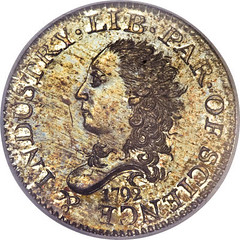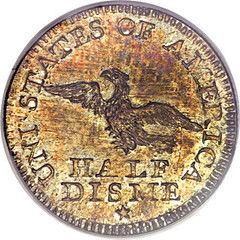
PREV ARTICLE
NEXT ARTICLE
FULL ISSUE
PREV FULL ISSUE
1792 HALF DISME SALES
In addition to the 1794 Silver Dollar, two examples of another important early U.S. coin changed hands recently - the 1792 Half Disme. First, here’s the Floyd Starr specimen sold by Heritage.
-Editor


From the Heritage Press Release: A unique and historic 1792 Half Disme realized $1.41 million dollars on Jan. 10 as part of Heritage Auctions’ U.S. Coin Florida United Numismatists (FUN) Signature Auction in Orlando, FL. The price realized, which includes 17.5% Buyer’s Premium, is a record for a Half Disme. The coin, previously owned by Floyd Starr, is graded Specimen-67 PCGS. It was the lead lot of the Heritage rare coin auction at FUN, which realized more than $44.9 million, and is among the best of all surviving examples of the issue. The mintage of these coins is variously estimated at 1,500 to 2,000 coins, based on documentary evidence left by Thomas Jefferson, though only an estimated 250 or so of them survive to this day, and none of them in better shape than the coin sold by Heritage Auctions on Jan. 10 in Orlando.
Here's some of the text from the Heritage web site lot listing.
-Editor
A simple memorandum, in three different versions, provides much of what we know about the 1792 half dismes, and yet, it has also been the source of much confusion. The first copy of this memo was discovered by Edward Haden early in 1943 and was brought to the attention of the numismatic world a few weeks later. Shortly after this announcement, Philadelphia numismatist Charles McSorley, Jr., incorrectly identified the author as Jonas R. McClintock. A second and slightly altered copy of the same memo came into the possession of Walter Breen in the early 1960s, and a third copy was acquired by Carl Herkowitz in 1995. It was this third copy of the memo, also slightly revised, that allowed a positive identification of the author, John A. McAllister, Jr. The earlier attribution of this memo to Jonas McClintock has been continually repeated over the last 60 years, and even today, the misattribution still appears in print. Herkowitz and coauthor Joel J. Orosz prepared a detailed article around this document, solved its authorship, and answered questions about the history of this famous coinage issue. Their article, "George Washington and America's 'Small Beginning' in Coinage: The Fabled 1792 Half Dismes," appeared in the 2003 edition of American Journal of Numismatics, second series, published by the American Numismatic Society in 2004. The text of the final version of the McAllister memo reads:
"Description of Half Dismes coined in 1792"
The study by Orosz and Herkowitz provides an in-depth examination of this memorandum, and also looks at much of the history of this issue. In the past, many false and unsubstantiated claims have appeared in print about this coinage issue. Among such claims is one that suggests Martha Washington posed as "Miss Liberty" for the engraver. Another claim that remains unsupported is that the Washingtons provided their family table service for the coinage. Both of these claims date back to 1860, when James Ross Snowden wrote: "The bust of Liberty is popularly supposed to represent the features of Martha Washington who is said to have sat for the artist while he was designing it ... This piece is said to have been struck from the private plate of Washington, which is not unlikely, considering the great interest which he took in the operations of the infant mint, visiting it frequently, and personally superintending many of its affairs." Today, the numismatic world is indebted to the efforts of Orosz and Herkowitz for correcting many past claims. Unfortunately, these authors allowed a new and unsubstantiated claim to be introduced. While an entry in Thomas Jefferson's "household account book" dated July 13, 1792, has been known for many years, a related entry dated July 11, 1792 was first published in the Orosz-Herkowitz study. The two entries read:
July 11, 1792: "Delivd. 75 D. at the Mint to be coined."
The catalogers go on to discuss a theory of Eric Newman's regarding how the bullion deposit could have been turned around into finished coinage in just two days. It also notes President Washington's November 6, 1792 declaration that "There has been a small beginning in the coinage of half dimes, the want of small coins in circulation calling the first attention to them."
Read the Heritage description for the rest of the discussion. I understand Len Augsburger, Joel Orosz and Pete Smith are working on a new book about these early coinages prior to the establishment of the first U.S. Mint. We'll look forward to their revised take on the evidence.
-Editor
To view the full lot description, see: 1792 H10C Judd-7, Pollock-7, R.4 as a Business Strike (coins.ha.com/c/item.zx?saleNo=1181&lotNo=5570) Pete Smith forwarded this note about the Cardinal Collection 1792 half disme that was sold by Stack’s Bowers on January 24th: The Knoxville – Cardinal 1792 half disme was sold by Stack’s Bowers with the sale of the Cardinal Collection on Thursday, January 24. Graded MS-68 by NGC, it is the half disme with the highest numerical grade. The coin achieved a hammer price of $975,000. The addition of a 17.5% buyers fee brings the price up to $1,145,625. In the past month there was much discussion on the Collectors Universe Forum about the Cardinal coin, certified by NGC as MS-68, and the Starr coin, certified by PCGS as SP-67. The general consensus was that the coins are very different and each is a fantastic and beautiful coin. The catalog for the Cardinal Collection included commentary on “America’s Most Distinctive Coin.” This was contributed by NBS members Leonard Augsburger, Joel J. Orosz and Pete Smith. The three researchers and authors are working on a book with the tentative title 1792: Birth of a Nation’s Coinage. Orosz has also contributed preliminary articles on the topic to The Numismatist, most recently for the December 2012 issue.

To view the complete Stacks-Bowers lot description, see:
Lot #13093. 1792 Half Disme. LM-1, Judd-7, Pollock-7, The Only Known Dies. Rarity-4. MS-68 (NGC).
(stacksbowers.com/auctions/auctionlot.aspx?lotid=433604)
The Numismatic Bibliomania Society is a non-profit organization promoting numismatic literature. See our web site at coinbooks.org. To submit items for publication in The E-Sylum, write to the Editor at this address: whomren@gmail.com To subscribe go to: https://my.binhost.com/lists/listinfo/esylum All Rights Reserved. NBS Home Page Contact the NBS webmaster 
|